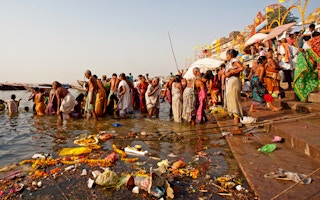Narendra Modi isn’t India’s first prime minister to draw the nation’s attention to the sad state of the river Ganga, with a promise to restore its glory, although his language and commitment to the cause of Maa (Mother) Ganga’s restoration appears direct and forceful. There is also talk of what is being presented as the Sabarmati model for rejuvenation of other rivers, in particular the river Yamuna in Delhi.
To continue reading, subscribe to Eco‑Business.
There's something for everyone. We offer a range of subscription plans.
- Access our stories and receive our Insights Weekly newsletter with the free EB Member plan.
- Unlock unlimited access to our content and archive with EB Circle.
- Publish your content with EB Premium.
It was Rajiv Gandhi, the then prime minister, who in 1985 first heralded the era of river cleaning in India and launched the Ganga Action Plan, GAP, with an objective of improving water quality of the river Ganga and its tributaries to bathing levels. All subsequent governments have not only continued with the programme but expanded its scope and coverage, so much so that by the end of December 2012, according to the annual report of the Environment Ministry, some Rs 4,032 crore (US$672 million) were spent on cleaning 41 rivers of the country across 190 towns in 20 states.
In 2012, the Department-related Parliamentary Standing Committee on Science & Technology, Environment & Forests, in its 224th report on demands for grants (2012-2013) that pertains to allocations under the XI and XII Five Year Plan of the Ministry of Environment & Forests, presented to the Rajya Sabha on 18th May, 2012 ruefully stated:
“The Committee takes note of fact that the initiative to clean Ganga started somewhere in the VI Five Year Plan under Ganga Action Plan. Thereafter, Ganga Action Plan-II and some other schemes with different names were operationalized by the Ministry but the end result is for everyone to see. The quality of Ganga water is going down day by day.”
Like GAP, there have been Yamuna Action Plans (YAP) in operation since 1993-94 with Japanese assistance. By the end of second phase of YAP in 2011, some Rs 1,500 crore had been spent on trying to clean the largest tributary of the Ganga, but with little success.
The fact is that river cleaning efforts since the mid-1980s have clearly failed to help revive or restore our rivers. Even after 30 years of the launch of Ganga Action Plan, there is not a single example of government-led successful river restoration in the country.
So, can we now expect miracles from the new Modi-led government?
In this context, the comment of Uma Bharti, the minister in charge of rivers, fills one with hope when she rejects the use of the term river ‘cleaning’ and uses the term river ‘rejuvenation’ instead. Some might ask what difference this makes. Bu it can make a lot of difference, when it comes to revival and restoration of rivers.
The quickest path to river rejuvenation is to let a river system be. This means a situation where a river, its tributaries and distributaries are allowed to “flow, freely and naturally” and “flood, freely and naturally”.
“
It must be understood that rivers are a natural system, and act like human veins and arteries for the earth. Just like a damaged artery can result in a serious health issue, so would a damaged river system for the nation and the earth.
But then that would entail removing existing obstructions to the flow like dams, barrages and embankments which trap a river within a restricted space. An ideal state for our rivers but one that the votaries of rapid economic growth would find preposterous.
Environmentalists and sadhus emphasized the need to remove existing obstructions and not to place new ones at the Ganga Manthan meeting called recently by Bharti to decide how to rejuvenate the river. But there was little mention of this in the official statement after the meeting, nor did this point of view find any echo in the programmes outlined in the Namami Ganga programme to rejuvenate the river, and for which a large amount of money has been allocated in this year’s budget.
We must understand that it is far more important and sustainable to have a ‘healthy’ and ‘happy’ nation than a ‘wealthy’ but ‘sick’ nation.
For health, as a nation we must breathe clean air, have access to and eat healthy food, and drink clean and wholesome water. This shall be possible only when our air is clean, soils are healthy and rivers have been revived and rejuvenated.
Above all, it must be understood that rivers are a natural system, and act like human veins and arteries for the earth. Just like a damaged artery can result in a serious health issue, so would a damaged river system for the nation and the earth.
Talking about specifics, the Modi government has been highlighting the rejuvenation of river Sabarmati in Gujarat as a success story. But we do not think so. What has been done is that a mirage of a river over mere 10.5 km of its total length of 350 km has been created passing through the city of Ahmedabad and that too at the cost of the river’s floodplains. Even the water present in Sabarmati doesn’t belong to the river itself, but has been taken from Narmada through a canal that happens to pass through the north of Ahmedabad. Clearly when there has not been any rejuvenation of the river properly, then how can it be championed as a role model for other rivers?
In more tangible and direct terms, the Ganga-Yamuna river system shall be truly restored only when their needs are understood and addressed in entirety. When each of their tributaries are given as much attention as the main river channels; when their ecological flows and security of flood plains are ensured by law and when the restoration of Ganga-Yamuna truly becomes a people’s movement and does not remain just a government run river ‘cleaning’ effort, only then will the rivers be truly conserved.
It’s too early to judge the actions and policies of Narendra Modi and Uma Bharti and only time will tell whether the current good and sincere intentions have resulted in finding the correct roadmap and taking right actions with sound and sustained results.
Manoj Misra is the Convener of Yamuna Jiye Abhiyaan, a NGO that strives for revival and rejuvenation of the Yamuna. This article originally appeared on The Third Pole.









